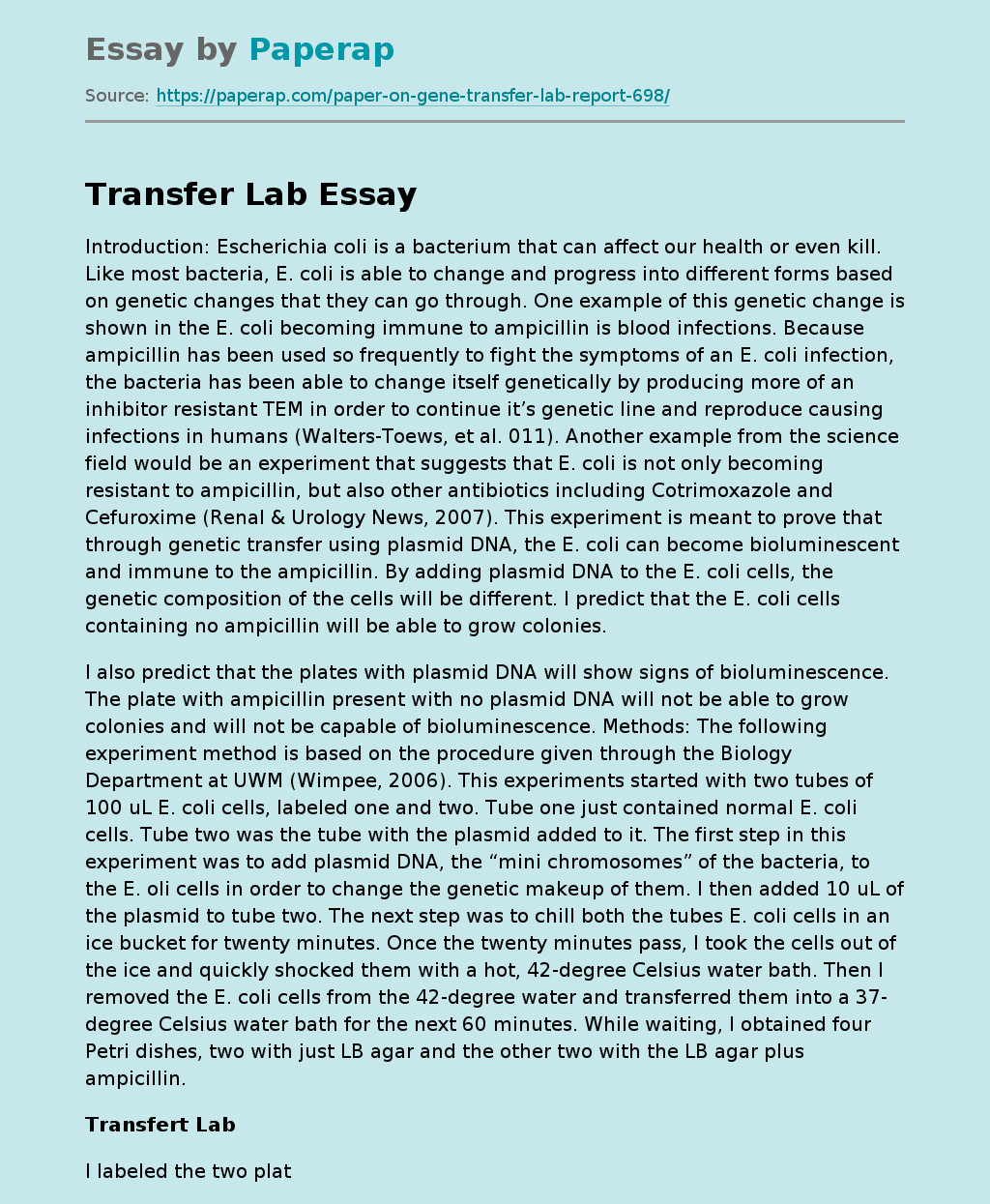Transfer Lab Escherichia coli
The following example essay on “Transfer Lab Escherichia Coli” is about a bacterium commonly found in the lower intestines of warm-blooded organisms, some strains of which can cause severe food poisoning.
Introduction
Escherichia coli is a bacterium that can affect our health or even kill. Like most bacteria, E. coli is able to change and progress into different forms based on genetic changes that they can go through. One example of this genetic change is shown in the E. coli becoming immune to ampicillin is blood infections.
Because ampicillin has been used so frequently to fight the symptoms of an E. coli infection, the bacteria has been able to change itself genetically by producing more of an inhibitor resistant TEM in order to continue it’s genetic line and reproduce causing infections in humans (Walters-Toews, et al. 011).
Another example from the science field would be an experiment that suggests that E. coli is not only becoming resistant to ampicillin, but also other antibiotics including Cotrimoxazole and Cefuroxime (Renal & Urology News, 2007).
This experiment is meant to prove that through genetic transfer using plasmid DNA, the E. coli can become bioluminescent and immune to the ampicillin. By adding plasmid DNA to the E. coli cells, the genetic composition of the cells will be different. I predict that the E. coli cells containing no ampicillin will be able to grow colonies.
I also predict that the plates with plasmid DNA will show signs of bioluminescence. The plate with ampicillin present with no plasmid DNA will not be able to grow colonies and will not be capable of bioluminescence.
Methods
The following experiment method is based on the procedure given through the Biology Department at UWM (Wimpee, 2006). This experiments started with two tubes of 100 uL E. coli cells, labeled one and two. Tube one just contained normal E. coli cells. Tube two was the tube with the plasmid added to it. The first step in this experiment was to add plasmid DNA, the “mini chromosomes” of the bacteria, to the E. oli cells in order to change the genetic makeup of them. I then added 10 uL of the plasmid to tube two.
The next step was to chill both the tubes E. coli cells in an ice bucket for twenty minutes. Once the twenty minutes pass, I took the cells out of the ice and quickly shocked them with a hot, 42-degree Celsius water bath. Then I removed the E. coli cells from the 42-degree water and transferred them into a 37-degree Celsius water bath for the next 60 minutes. While waiting, I obtained four Petri dishes, two with just LB agar and the other two with the LB agar plus ampicillin.
Transfert Lab
I labeled the two plates without ampicillin A and B and the two plates with ampicillin C and D. After the 60 minutes had passed, take the E. coli out of the bath and pipet 100 uL of cells from the first tube (no plasmid) and spread onto plates A and C. With the second tube, pipet 100 uL of cells onto plates B and D. Using five sterile glass beads spread the E. coli cells around the petri dishes. Place all of the petri dishes into a 37-degree incubator for about twelve to sixteen hours. After that time had passed, I stored the plates in the refrigerator until I came back one week later to view the results.
After the week passed, I checked the plates to see how much the E. coli cells grew and checked the bioluminescence in a dark room. Results: After the week my results are as shown in the table. Plate A and B had a lot of cell growth with no bioluminescence. Plate C had no cell growth and no bioluminescence. Plate D had almost 70 colonies of cells with bioluminescence.
Discussion
Based on the results of my experiment, my predictions were mostly correct. The plates that had no ampicillin had a lot of growth and the plates with plasmid injected E. coli both were able to grow cells and became bioluminescent. The only result that was not predicted was that there was no bioluminescence on Plate B when it was expected. This can be explained because the plate becomes overpopulated with E. coli cells and the plasmid DNA is not 100% successful in changing the genetic composition of the E. coli. So, there really is bioluminescence but there are just so many cells that you cannot always see it.
My results were pretty similar to the results of the rest of the class. Based on the results, my hypothesis is also correct because changing the DNA of the E. coli cells causes genetic changes. In this experiment, the DNA caused the cells to be immune to the ampicillin and still able to reproduce. This experiment shows that there is a need to have concern for the development of different strains of bacteria or the change of these bacteria that can affect the health of many.
Transfer Lab Escherichia coli. (2019, Dec 05). Retrieved from https://paperap.com/paper-on-gene-transfer-lab-report-698/

